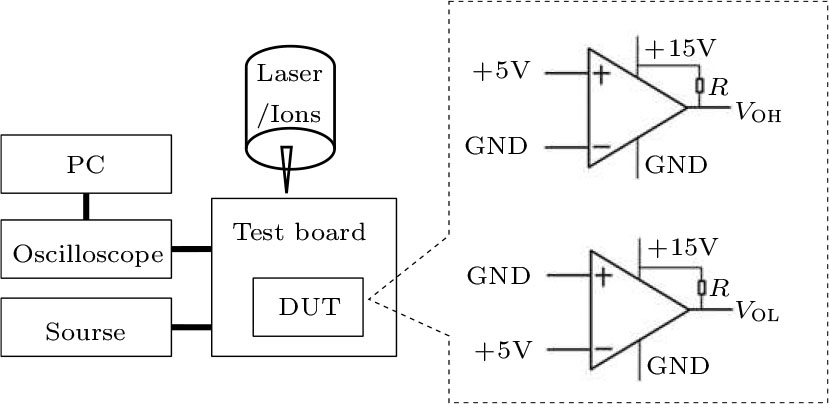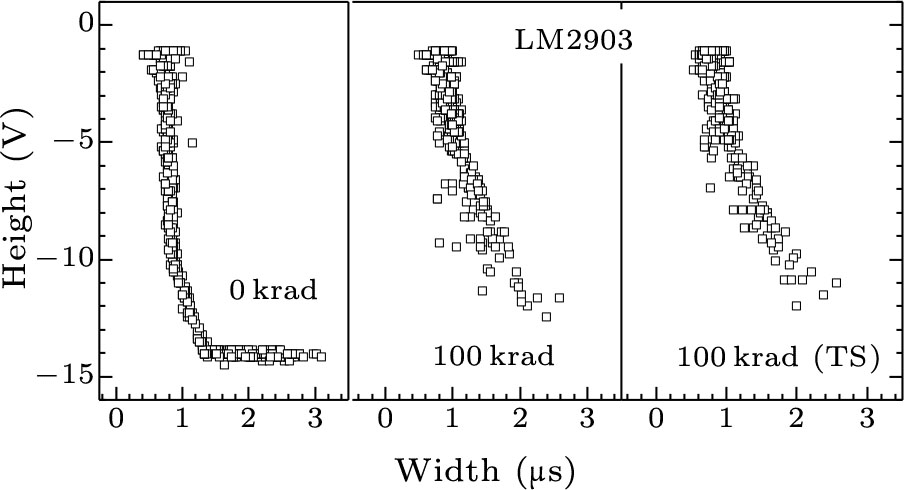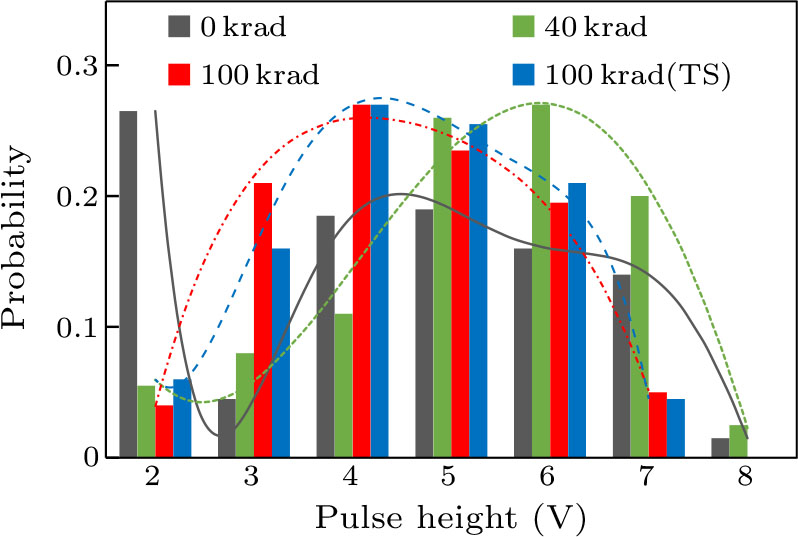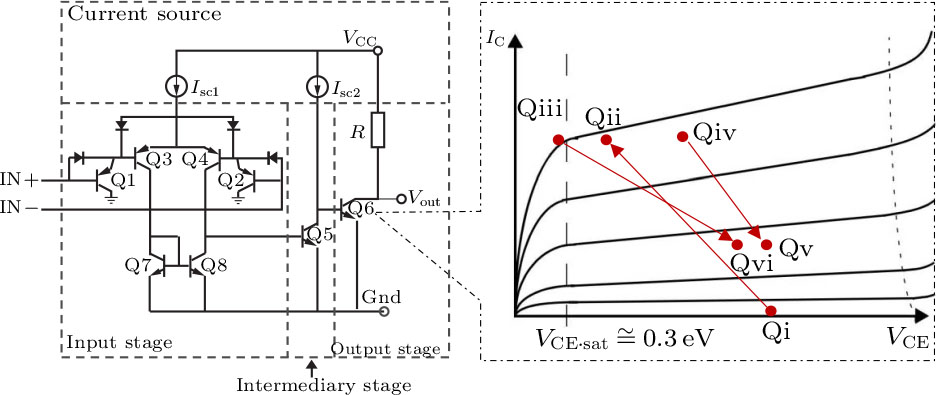Abstract
The synergism effect of total ionizing dose (TID) on a single event transient (SET) in a bipolar comparator is investigated. Experimental results show that the shapes of the SET are considerably influenced by the TID accumulated in low dose rates. The variation tendency of SET shapes can be accurately simulated by temperature switching irradiation. The mechanism of this synergism effect is also analyzed in brief via the operating schematic of a comparator. After the accumulation of 100 krad(Si), the lower tendency of negative SET can be attributed to the degeneration of β. The change tendency of a positive SET, either lower or higher, is dependent on the load condition that limits the output range of the comparator.
Export citation and abstract BibTeX RIS
Actually different radiation effects coexist in the space environment, in which a broad spectra of cosmic rays can be found. For a bipolar linear circuit, the total ionizing dose (TID) and single event transient (SET) are two major issues during space services. Satellite anomalies induced by SETs occur in liner circuits and are frequently reported, such as in TOPEX,[1,2] SOHO,[3] Cassini,[4] and WMAP.[5] Considering the SET characteristics of a liner circuit, GSFC prepared testing guidelines for the assessment of SETs.[6] The impact of the TID on SETs was demonstrated by Bernard et al.[7] and Buchner et al.[8] via a comparison of the shapes of SETs under laser illumination. A further study on the operating configurations reveals that the SET error rate can either decrease or increase, following the TID exposure.[9] However, the separate testing of different radiation effects is usually made by ground experiment facilities in which the comprehensive space environment cannot be truly simulated.
Moreover, enhanced low dose rate sensitivity (ELDRS) dominates the degeneration of the bipolar circuit over a long service life in space. Comparing the ELDRS results on the ground and observations in orbit by MPTB,[10] a dose rate of 10 mrad(Si)/s is proposed as a standard test condition to evaluate ELDRS in method 1019.6. This means that a four-month test period must be costed during the radiation hardness (RH) development phase. Moreover, no specific accelerated test procedures are currently provided in method 1019.9.[11] Considering the distinction between space and ground conditions, the synergism effect is beyond the scope of the current test method and is of concern to spacecraft electronics.
In this Letter, to simulate the SET influences by ELDSR for long service in space, the synergism effect of the TID on the SET of the bipolar comparator is investigated using low dose rate (LDR), temperature switching (TS), laser, and heavy ions experiments. Compared the SET results of samples irradiated in LDR and TS, the TS procedure is validated for the synergism effects in comparators LM139 and LM2903. The prime mechanism of the synergism effect is also briefly discussed.
Two comparators with the same structure, LM139 and LM2903, fabricated by the bipolar process, were selected for the study of the synergism effect in the LDR and TS procedures. The TS approach proposed by Lu et al.[12–15] can give a more conservative evaluation result of ELDRS within 10 h. Therefore, a four-step TS procedure, 0–20 krad(Si) at 120°C, 20–40 krad(Si) at 100°C, 40–80 krad(Si) at 65°C, and 80–100 krad(Si) at 50°C, was utilized as the accelerated TID, while an LDR of 10 mrad(Si)/s was used as the standard on 60Coγ. The samples were irradiated using the worst-case scenario with a static bias condition and pins connected to GND.[16,17] Then the SET experiments using laser and heavy ions were performed for the test conditions, as shown in Fig. 1. The SETs were tested using a digital oscilloscope working in the fast trigger mode to capture every SET, while the vertical and horizontal setups were suitable for capturing a whole pulse signal. Once the SET reaches the trigger threshold, the digital oscilloscope will capture the pulse signal and wait for the next one, until all can be captured. All ranges of the selected heavy ions were beyond 50 μm in Si to ensure that the Bragg peaks were beyond the deepest SET sensitive junction.[6]
Fig. 1. Test condition of the SET test. Two typical working statuses are set: high and low level outputs.
Download figure:
Standard imageTo consider the impacts of annealing, a room temperature anneal test was carried out with all pins placed in conductive foam, as under the same conditions for transportation to the SET experiment facilities. The annealing results in Fig. 2 show that only a slight variation occurred after 10 day and therefore the effects of annealing were omitted in the following SET experiments, within 3 day after 60Coγ irradiation. Moreover, this accelerated procedure was validated for LM139 and LM2903 with a worse degeneration in TS compared with an LDR according to method 1019.9.
Fig. 2. Annealing results of the LDR and TS experiments for LM2903 and LM139. The LDR, TS, and anneal experiments were carried out at the Xinjiang Technical Institute of Physics and Chemistry, Chinese Academy of Sciences.
Download figure:
Standard imageThe variations were clearly observed in the SET shapes captured under laser after a 100 krad(Si) dose accumulation. The LM2903 had divergent tendencies with positive SET variations, depending on the output resistor, as illustrated in Fig. 3. The height and width both increased for the 5 kΩ output resistor, while the height was reduced for the 1 kΩ output resistor. When it comes to negative SET, there was no high amplitude SETs for LM2903, as shown in Fig. 4. It is noteworthy that the influence of the TID on the SET shapes in the low dose rate environment can be accurately simulated by the TS procedure via a comparison using scatter plots of TS and LDR. LM139 had a similar tendency as LM2903.
Fig. 3. SET height versus width under scanning of a picosecond pulse laser with an equivalent LET of Xe (57.36 MeV·cm2/mg). The laser experiments were carried out at the National Space Science Center, Chinese Academy of Sciences.
Download figure:
Standard imageFig. 4. Negative SET height versus width under scanning of a picosecond pulse laser with an equivalent LET of Xe (57.36 MeV·cm2/mg).
Download figure:
Standard imageA verification of the TS procedure was also performed under the condition of heavy ions. A probability distribution plot of SET heights is shown in Fig. 5 to illustrate the synergism results in LM139. The negative SETs under Xe in Fig. 5 presents the same variation tendency as that of the laser in Fig. 3 with an equivalent LET of Xe. For an accumulating dose with LDR, the percentage of high amplitude SETs is transferred to the lower parts, as shown in Fig. 4. There were no significant SETs after 100 krad irradiation under Xe, Kr, or Fe, while the SET numbers with heights between 14 and 15 V decreased to 15.9% under Ta. This tendency can also be simulated by the TS procedure under heavy ions, according to the probability distribution of the SET height, as shown in Fig. 6. For an accumulating dose in LDR, the percentages of low and high SETs were both transferred to the middle part under Kr. The probability distribution with TS had a similar outline to that of the LDR.
Fig. 5. Probability distribution of negative SET heights under heavy ions: Fe (31.21 MeV·cm2/mg), Kr (31.21 MeV·cm2/mg), Xe (57.36 MeV·cm2/mg), and Ta (80.5 MeV·cm2/mg). The heavy-ion experiments under Fe, Kr, and Xe were performed at the Radiation Effects Facility, University of Jyväskylä, and those for Ta at the Heavy Ions Research Facility, Institute of Modern Physics, Chinese Academy of Sciences.
Download figure:
Standard imageFig. 6. Probability distribution of negative SET heights with different dose accumulations for LDRs and TS under Kr (31.21 MeV·cm2/mg).
Download figure:
Standard imageAccording to the schematic of LM2903/LM139 in Fig. 7, Q6 is controlled by the state of Q5 that in turn depends on the state of the input stage. As it is known that off-state transistors are considered to be sensitive to SET, the hits in Q2, Q4, Q8, or Q5 cause a positive SET to propagate to a low level output, while hits in Q1, Q3, Q7, Q8, or Q6 lead to a negative SET in a high level output. The mechanism of the synergism effect on SET height can be different depending on the output resistor. A brief discussion is made by analyzing the operating point of the output stage in Fig. 7. After a 100 krad(Si) dose accumulation, the Qi–Qvi represent the maximum range of the operating point.
Fig. 7. Schematic of LM2903/LM139 and operating points response to SET after TID experiment. Qi to Qv represent different operating points of the output stage. Qi represents high level output when no SETs occur. Qii represents negative pulse when SET occurs. Qiii represents low level output when no SETs occur (R = 5 kΩ). Qiv represents low level output when no SETs occur (R = 1 kΩ). Qv and Qvi represent positive pulse when SET occurs.
Download figure:
Standard imageWith a high output resistor of 5 kΩ, the SET height is influenced by the degeneration of β. To the first order, the variation of the SET height is proportional to the reduction of β in Q6 as follows:



where IC is the collector current of Q6 during SET. When a hit directly occurs in Q6 or an SET propagates from an input stage to output stage, the transient current switches the operating point of an output stage from Qi to Qii, as shown in Fig. 7, which changes the output level from high to low. The operating point of Q6 is shifted into the liner region when the SET occurs. According to Eq. (1), the height of a negative SET is proportional to the voltage drop on the 5 kΩ output resistor with a reduction of β. Therefore, the height of a negative SET presents a lower tendency after irradiation, as illustrated in Fig. 4. Similarly, for a positive SET, the IB of Q6 is shunted by a transient of state Q5 induced by a hit or propagation from the input stage. As a consequence, the output is moved to a high level by the shifting of the operating point from Qiii to Qv, as shown in Fig. 7. According to Eq. (2), the height of a positive SET is larger with a reduction of β. Therefore, the height of a positive SET presents a larger tendency in LM2903 with 5 kΩ output resistor after irradiation, as shown in Fig. 3.
With a low output resistor of 1 kΩ, the SET height is influenced by the lifting of the low output level as

where IC originates from the output stage itself before SET while IC in Eq. (2) comes from the SET. After 100 krad(Si) dose accumulation, the operating point of Q6 shifts from the saturation region to Qiv because of the degeneration of IC, and this leads to a significant lifting of the low output level, which heavily limits the range of SET. Due to the shrinking SET range from Qiv to Qv in Fig. 7, the SET with height above this SET range cannot be outputted, while the lifting of the low output level is much smaller with 5 kΩ output resistor according to Eq. (4) and it can be omitted. Because of the above difference compared to 5 kΩ, Eq. (2) no longer works with the 1 kΩ output resistor. Thus the positive SETs of LM2903 with 1 kΩ presented a lower tendency.
In summary, the synergism effect of TID on the SET has been demonstrated in bipolar comparators LM2903 and LM139 under laser and heavy ions. The synergism mechanism is briefly discussed for the schematic of the operating circuit. The tendency of the SET variations is dependent on the reduction of β, and the lifting of the low output level under different bias conditions. These synergism effects in LDR environments can be simulated via the time-saving TS procedure, which are noteworthy for the RH development of a system during hardness assurance/lot acceptance testing.
We would like to thank the support of the National Space Science Center, Chinese Academy of Sciences, Heavy Ions Research Facility, Institute of Modern Physics, Chinese Academy of Sciences, and Radiation Effects Facility, University of Jyväskylä.
Footnotes
- *
Supported by the National Natural Science Foundation of China under Grant Nos U1532261 and U1630141.







